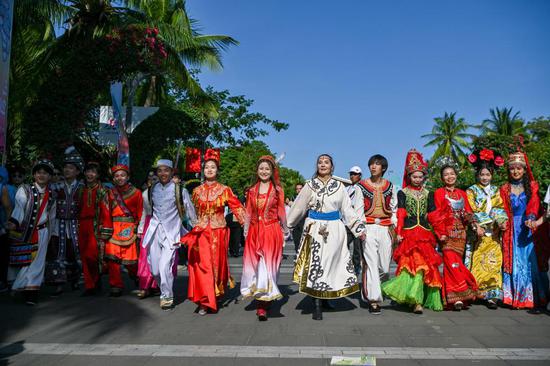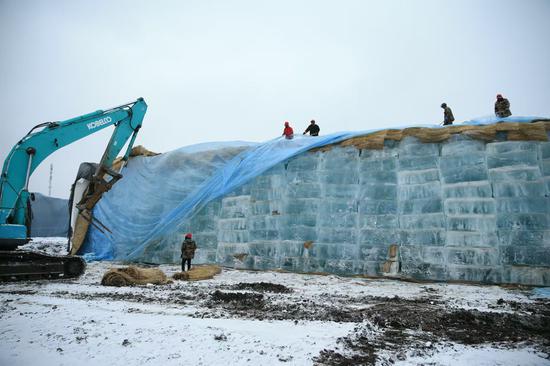China's ice and snow economy is thriving, turning its natural "cold resources" into a burgeoning "hot economy" for the nation.
From expanding ski resorts to increasing visits by skiers, the rise of snow tourism is creating fresh opportunities for regions across the country as winter takes hold, amid strong support from government policies and infrastructure development.
Zhao Yin, a 28-year-old marketing professional from Shanghai, and her friends visited Songhua Lake Ski Resort in Northeast China's Jilin province late in November.
She said the trip, along with other ski and snowboard lovers, was memorable and ended up costing only about 3,000 yuan ($412), thanks to seasonal discounts on flights, ski fees, and local consumption coupons.
"Being in nature and focusing on the moment are a lot of fun, especially when you are with a group of friends," she said of her outing in the new snow season.
Zhao, an avid snowboarder, also hires private instructors to refine her skills, though not for every ski trip, paying an average of 500 yuan per hour.
"Each time I snowboard, I feel like I learn something new. It's all about controlling your body," she said.
Zhao's enthusiasm reflects a broader trend.
Wu Bin, founder and CEO of Beijing Snowpal Enterprise Management Co Ltd, said: "The passion to experience and participate in skiing has surged, stimulating ice and snow tourism across the country."
The winter sports industry in the country saw a 16.3 percent increase in skier visits during the fiscal year ending on April 30, 2024, with 23.08 million visits recorded compared to 19.83 million in the previous year, according to the China Ski Industry White Book (2023-24) released in November.
The number of individual skiers grew 14.5 percent to 12.8 million, and the per capita skiing frequency increased to 1.8 times from 1.77 times last year, according to the report, which has been compiled by Beijing Snowpal.
Supporting this growth has been a boom in the development of ski resorts.
Li Xiangbao, marketing manager at Keketuohai International Ski Resort in Altay, Xinjiang Uygur autonomous region, said the resort welcomed over 3,000 visitors within just 10 days of its opening.
Since November, the daily average number of tourists has exceeded 2,000, with 90 percent traveling from other provinces, Li said.
"On weekends, hotel rooms in the resort area are nearly fully booked. As winter deepens, tourist numbers continue to climb rapidly," he said.
This strong start exemplifies the booming growth of the country's ice and snow economy, boosting confidence in the development and upgrade of ski resorts nationwide.
Keketuohai International Ski Resort is planning extensive upgrades, including the renovation of 23 ski slopes with a combined sliding length of 61 kilometers, and the addition of ski-in, ski-out accommodations.
Other resorts are also expanding their offerings.
Jilin's Beidahu Ski Resort has added 100 snowmaking machines, increased its number of ski slopes from 64 to 74, expanded the slope area from 239 to 275 hectares, and improved its total hotel bed capacity to 9,000.
In Chongli, Hebei province, ski resorts have undergone upgrades to cableways, safety nets, and other essential facilities. Some have introduced new attractions, including night skiing and snow amusement parks, to enhance the visitor experience.
According to the white paper, this snow season, 30 new ski resorts have opened across the country, evenly split between indoor and outdoor facilities. This has brought the total number of operational ski resorts to 719, an increase of 22 from the previous year.
The number of resorts equipped with aerial ropeways — a key infrastructure for ski tourism — has risen by 10, reaching 176, said the report.
Among these facilities, indoor ski resorts have shown major growth.
The country has added 15 new indoor ski resorts, while five were closed. With 60 operational indoor resorts, they now account for 8.34 percent of all ski resorts and attracted 4.88 million skier visits, a 33.7 percent year-on-year increase.
The rise of snow tourism is particularly evident in regions like Jilin, Xinjiang, and Heilongjiang province, which have seen significant growth in skier visits.
Jilin rose to the top spot among provinces for skier numbers, overtaking Hebei, while Heilongjiang recorded an 88.65 percent increase in skier visits — the highest nationwide. Xinjiang followed with a 56.48 percent rise, and Beijing, though dropping to fourth place, remains a key hub for winter sports enthusiasts, said the report.
Meanwhile, Harbin in Heilongjiang came to national attention thanks to its winter attractions. The term "Erbin", a nickname of Harbin, known for its ice and snow festival, has gained popularity across the country.
Even in Changchun, capital of Jilin, the number of online discussions about "ice and snow tourism" increased 10-fold compared to the same period in 2023.
The influx of visitors is transforming local economies.
In the fourth quarter of 2023 alone, 19 national ski resorts recorded 9.43 million tourist visits, with average daily guest numbers approaching 500,000 for the first time. Revenue from these resorts soared, with average tourism income increasing 5.43 times year-on-year, according to Li Yu, director of the ice and snow industry research center, the Institute of Geographic Sciences and Natural Resources Research in China.
China's ski resorts cater to various customer groups, from casual tourists seeking unique experiences to enthusiasts pursuing destination vacations, said the white paper.
Among the 719 operational resorts, 29 are classified as destination vacation resorts, known for their comprehensive offerings, including skiing, accommodation, and entertainment. These resorts attracted 6.6 million skier visits during the recent season, a 52.87 percent year-on-year increase, according to the report.
Infrastructure plays a pivotal role in the efficiency and appeal of ski resorts, said the white paper. As of April 30, 2024, there were 355 aerial ropeways across 176 ski resorts nationwide, with 114 of these being detachable aerial ropeways, spanning 39 resorts. However, growth in other key areas, such as new magic carpets, has slowed slightly, with 110 new installations covering 18,000 meters.
Snow grooming and snowmaking equipment are also expanding, with about 60 imported snow groomers added this season and an estimated 1,200 new snowmaking machines deployed across the country.
However, ski resorts report a significant surge in demand for snowboards, highlighting a critical shortage in rental equipment to meet the needs of eager visitors, said the report.
China's ice and snow equipment industry is making strides, with domestic brands emerging as key players in both competitive sports and field equipment.
Taishan Sports Industry Group Co Ltd, a supplier for the Olympic Games, is an example of this growth.
The company has developed innovations, including a big data ski simulator, polymer ice boards, and mobile ski facilities.
Despite its rapid expansion, the winter sports industry faces challenges.
Liu Simin, vice-president of the tourism unit of the China Society for Futures Studies, highlights the high entry barriers for ice and snow sports, including costs, physical fitness, technical skills, and infrastructure.
"The construction of facilities needs to be strengthened, service levels improved, and consumer products diversified. At the same time, consumers' purchasing power must keep pace to sustain the industry's growth," Liu said.
"At present, there are very few Chinese enterprises with the technological innovation capabilities to compete at the forefront of the industry," said Song Kun, marketing head of Taishan Sports.
The government's strong support for the industry is helping address these challenges. Policies promoting winter tourism, coupled with the legacy of the 2022 Winter Olympics, have created a solid foundation for growth, Wu added.
The State Council, China's Cabinet, recently issued a circular on measures to stimulate the vitality of the ice and snow economy to promote the sector as a new growth point.
By 2027, the total scale of the ice and snow economy will reach 1.2 trillion yuan, and by 2030, the total scale of the ice and snow economy will reach 1.5 trillion yuan, it said.


















































 京公网安备 11010202009201号
京公网安备 11010202009201号